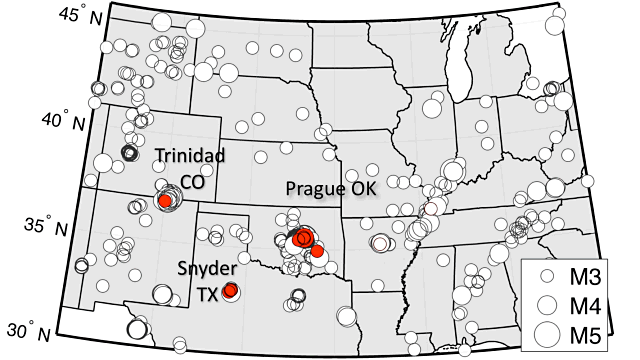I always start my day by checking the U.S. Geological Survey earthquake map to see what’s been happening in California. Almost every day there are earthquakes of magnitude 3 here; they feel almost routine. But east of the Rockies, M 3 quakes are rare events that get in the newspaper. They’re big enough to alarm people though they seldom cause any damage. And in the last few years they’ve been getting more common, especially in association with oil and gas operations.
These human-induced earthquakes are not related to hydraulic fracturing, but to very deep disposal wells that inject waste fluids—formation brine, excess fracking fluid and the like. Over 100,000 injection wells of this type are operating in the United States. Almost all of them make no problems: they do their thing far away from water supplies and are monitored closely. But a handful of wells, maybe a dozen, have gone on to produce unexpected earthquakes.
In today’s issue of Science, a team of researchers reports that injection fields approaching an earthquake-ready state may give us a telltale sign: seismic waves sweeping through from huge distant shocks set off tiny local shakers in the process called dynamic triggering.
Dynamic triggering was first documented after the Landers quake in June 1992, when the M 7.3 rupture in Southern California set off tiny earthquakes over 1000 kilometers away in places like Yellowstone. Today many examples of dynamic triggering have been documented, and it’s no longer a scientific controversy. Since that time we’ve learned that earthquake faults are generally stressed quite near to their rupture point, and from that it would seem that the closer they get to rupture the more likely the slightest disturbance will set them off. I say “it would seem” because ordinary natural disturbances, like tides, magnetic fluctuations and weather fronts, don’t trigger earthquakes. Today’s Science paper fits into that background state of knowledge.
The United States was shaken from a distance by three recent great quakes: Chile on 27 February 2010 (M 8.8), Japan on 11 March 2011 (M 9.0) and Sumatra on 12 April 2012 (M 8.6). The seismic waves were very slow and moved the ground by mere millimeters; only seismometers could feel them. They left the midcontinent unperturbed, except near three injection-well sites in the southern Plains states that later produced earthquakes of their own. The map below shows those sites and the small events (red dots) that were triggered by the distant quakes.

Trinidad, Colorado, is the site of fluid injections related to coalbed methane production. The area had a quake swarm in August 2011 that included a M 5.3 event. The 2010 Chile quake triggered four shocks there within a day and many more nearby over the next few weeks. The 2011 Japan quake had no effect and the 2012 Sumatra quake triggered only a few shocks.